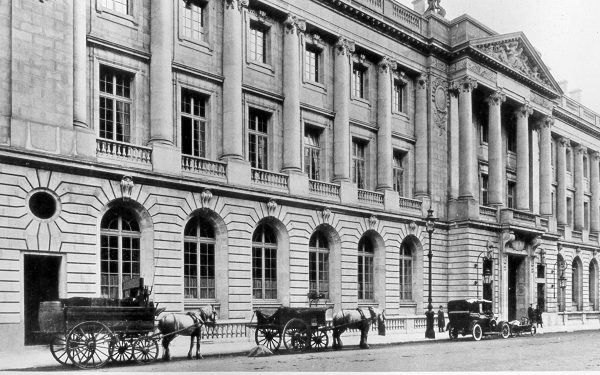History of the Pall Mall Clubhouse

On its foundation in 1897, the Automobile Club of Great Britain’s first premises had been at 4 Whitehall Court (just four rooms). As a result of the rapid growth of the motoring movement in the following decade, the Club was soon to outgrow what had become its second home at 119 Piccadilly, which it had acquired in 1902. [At the time, the Club also possessed adjoining offices at other Piccadilly addresses and Down Street.] ‘119’ had certainly been a grander affair than Whitehall Court, with library, reading room, dining room and balcony (with a pleasant outlook over Green Park), card room, billiard room, smoking room, and bedrooms, and ample garage space. But with the Club’s membership having risen from an initial 163 at the inaugural meeting in 1897 to approximately three and a half thousand members by 1907, the need for a much larger domicile became all too apparent.
With the granting of the ‘Royal’ prefix by His Majesty King Edward VII that year too, a grand, new, ‘state-of-the-art’ clubhouse was considered desirable to reflect the Club’s already established reputation as the ‘Parliament of Motoring’. The Club commissioned fashionable Edwardian architects Charles Mewès and Arthur Davis (along with E. Keynes Purchase) to carry out the project; they had already been highly lauded for the recently built Ritz hotels in Paris and London, and for the interiors of many of the great ocean-going liners of the day.
An eclectic mix of Classical, French, and English architectural styles was to characterise the clubhouse in Pall Mall, which occupies a site of nearly one acre. Painstaking detail was lavished on every area, seen and unseen. After three particularly challenging years of construction (1908-10), Club members finally moved into the new clubhouse in March 1911. It had cost, for what was considered then, the huge sum of £330,000 (£250,000 on the building itself and £80,000 on its interiors). A ‘mini-palace of opulence and Edwardian hedonism’ was one exuberant description at the time. From the start, its sporting and recreational facilities, including the Graeco-Roman swimming pool and Turkish Baths, were especially admired.
For more than a hundred years then, this Historic England Grade II* building has dominated the Pall Mall thoroughfare. The only major structural change has been the addition of twenty-two new bedrooms on a newly created fifth floor back in the 2000s. By the 1970s, the interiors were very run-down. With the convening of a special committee, there has been an extensive programme of refurbishment ever since of the principal rooms, including the spectacular ‘flagship’ restaurant, the Louis XIVth-styled Great Gallery.


